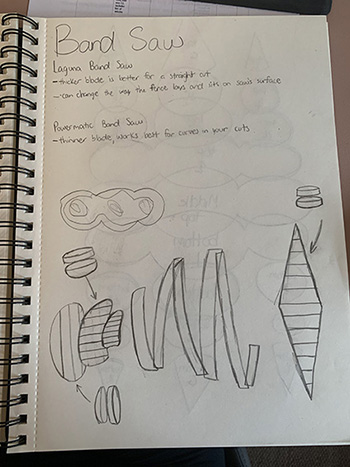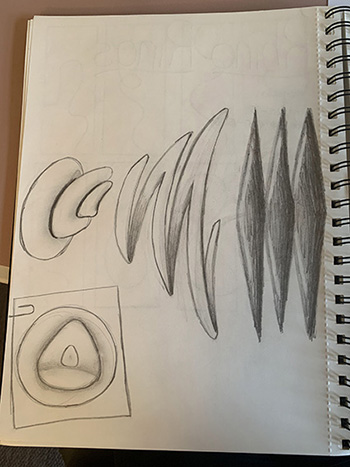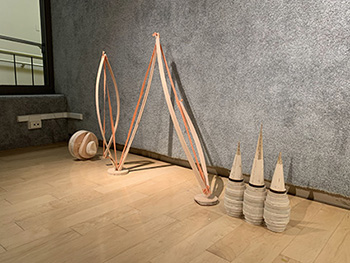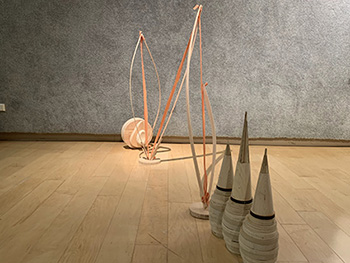Studio Art
"Gravity is an unavoidable fact of working in the three-dimensional world. Understand what goes into creating work that is equal parts innovative and functional in its appearance and stability. Explore how the design of an identical repeated unit can lend itself to verticality, implicit use, experimentation and visual harmony. Final piece should show an understanding that the whole is of greater importance than the individual unit."
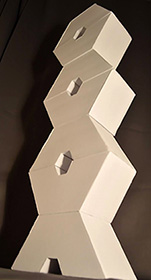 My process for the column project began with researching some sort of form I could work with. I researched baby’s toys, since they tend to stack in a repetitive way, and came up with an idea that I thought would work well for the project. When we moved onto how we would create the column itself, however, I realized that it would be difficult to create the curves and rounded shapes that I originally wanted to be in my project. So I instead moved to a new idea that was still the
My process for the column project began with researching some sort of form I could work with. I researched baby’s toys, since they tend to stack in a repetitive way, and came up with an idea that I thought would work well for the project. When we moved onto how we would create the column itself, however, I realized that it would be difficult to create the curves and rounded shapes that I originally wanted to be in my project. So I instead moved to a new idea that was still the 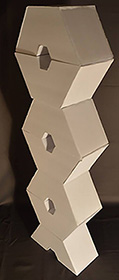 same shape, but made the edges more straight-cut. Creating a cube out of foam board took me a while to get the hand of, and even still its wasn’t perfect. I knew creating my column was going to be difficult. I made a paper model to begin with so that I had something to base the rest of my cuts on. From there I measured and cut each piece and used tacky glue to assemble each module. Stacking them in the way that I did when they were finished made me think of a hex nut, and for some reason I enjoyed the way they looked like that.
same shape, but made the edges more straight-cut. Creating a cube out of foam board took me a while to get the hand of, and even still its wasn’t perfect. I knew creating my column was going to be difficult. I made a paper model to begin with so that I had something to base the rest of my cuts on. From there I measured and cut each piece and used tacky glue to assemble each module. Stacking them in the way that I did when they were finished made me think of a hex nut, and for some reason I enjoyed the way they looked like that.
"Find ways to explore the translation of one or more human senses into a 3D visual expression. Using an assigned spice, carve a plaster volume based on your findings that explores movement, character, and gesture in form utilizing concavity and convexity, with intention of expressing your experience with the assigned scent/smell."
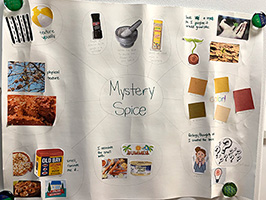 My reduction project began with a mystery spice and thinking about how it smelled, what did the spice remind me of, how did it make me feel, what did I associate the smell with. I began thinking about all of these things and created a web with images.
My reduction project began with a mystery spice and thinking about how it smelled, what did the spice remind me of, how did it make me feel, what did I associate the smell with. I began thinking about all of these things and created a web with images.
From there I came up with three adjectives (fishy, coarse, and textured) that best described my spice and began sketching how I wanted to convey a nonvisual form into a visual element. The first sketch is below:
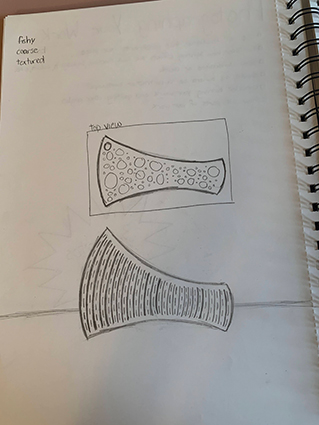
Although this sketch did represent the adjectives I came up with, I felt it wasn’t as strong as I could make it. So I did some research on how fish move when they are out of water and on a dock. From there I came up with the sketches below:
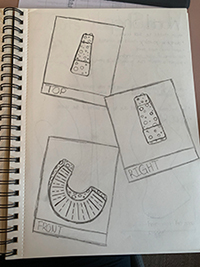

I was happy with the representation I had come up with, so I began carving my plaster block. Midway through the process, I thought about the textured adjective I had come up with and decided to change the texture from the side to the center of the C shape. I felt the raw edges contrasted the smoothness of the bumps well and represented texture more than what I had originally thought.
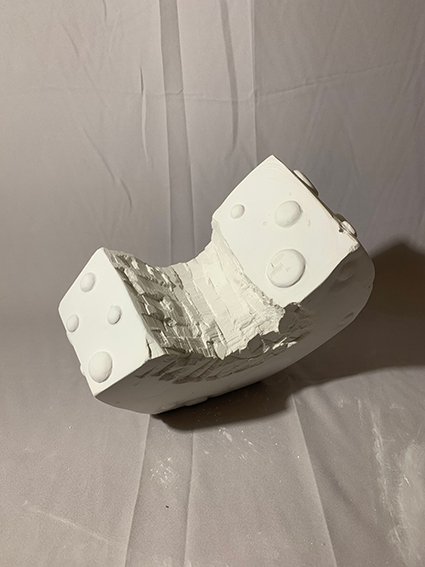
"Using a 4”x4”x6” block of wood, Make two cuts with a bandsaw. One cut is considered entering and exiting the material one time. Use the cut pieces to develop an interesting composition that explore form, negative space and visual harmony."
I had never done any work in a wood shop prior to this project, so as I look back on it, I realized that this project served as an introduction to using the saws and sanders available to us for our larger wood project. I actually really enjoyed this project, it was done in a short in time period, but I also liked the freedom and ease of it. I began with some sketches, they were very abstract, simple random lines and curves that I thought could create something interesting once cut out. I really didn’t know what I created until both cuts were done and I took them apart. After my two cuts were complete, I took my pieces and played with how I could assemble them. I was able to use a nail gun to connect them and I knew I wanted it to be dark in color.
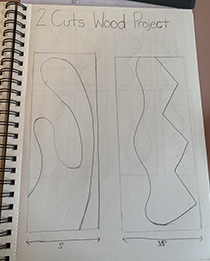
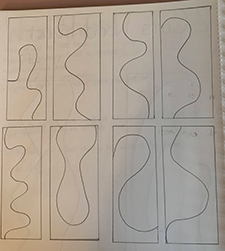
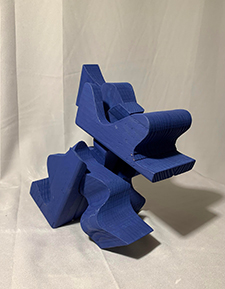
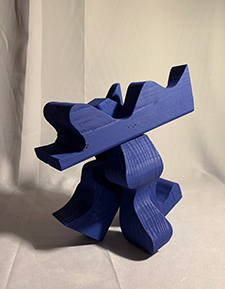
"Design a series of three wearable (or non-wearable rings) in Rhino’s 3D modeling software. These rings will be printed using the school’s digital fabrication lab."
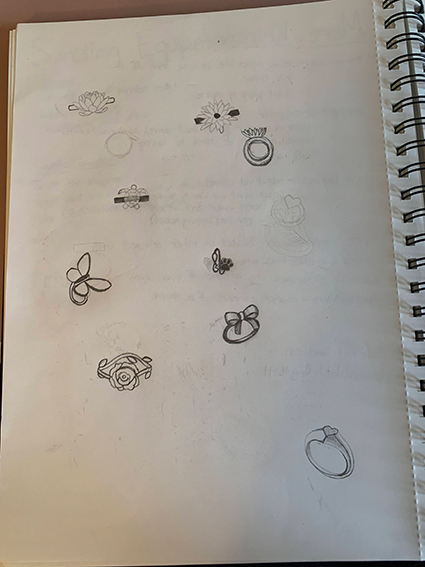 I started getting ideas for my rings by looking at pictures of nice jewelry ring designs and other 3D printed rings. The first one I came upon was a turtle. Although I have never 3D printed anything nor used any 3D printing software to design anything, I do have experience with AutoCAD software. I began with the turtle ring since I thought it would be the easiest to create. The turtle was quite 2 dimensional, a few curves were made and adjusted to create it. I knew it was going to be a simple ring, but that was what I wanted. After I finished the turtle ring, I decided to move to the butterfly ring. I wanted this ring to have a bit more dimension. Rather than a sitting butterfly, I decided to create one that was in flight. I began my design by creating butterfly wings with curves. After extruding them, I angled the wings towards each other to make the butterfly take flight. After my butterfly was created, I decided to keep the theme of animals for my rings. For my last 3D printed ring I made a ladybug. I began with an ellipsoid and shaped it to the way a ladybug would look. I duplicated the ellipsoid to make the wings and then used a third ellipsoid to create the head. Finally, spheres were added for eyes. Although on the Rhino software my ladybug ring looked a little dull and boring, I wanted the paint to make the ring. While my other two rings were solid in color, I knew I wanted this ring to have multiple colors to represent the ladybug.
I started getting ideas for my rings by looking at pictures of nice jewelry ring designs and other 3D printed rings. The first one I came upon was a turtle. Although I have never 3D printed anything nor used any 3D printing software to design anything, I do have experience with AutoCAD software. I began with the turtle ring since I thought it would be the easiest to create. The turtle was quite 2 dimensional, a few curves were made and adjusted to create it. I knew it was going to be a simple ring, but that was what I wanted. After I finished the turtle ring, I decided to move to the butterfly ring. I wanted this ring to have a bit more dimension. Rather than a sitting butterfly, I decided to create one that was in flight. I began my design by creating butterfly wings with curves. After extruding them, I angled the wings towards each other to make the butterfly take flight. After my butterfly was created, I decided to keep the theme of animals for my rings. For my last 3D printed ring I made a ladybug. I began with an ellipsoid and shaped it to the way a ladybug would look. I duplicated the ellipsoid to make the wings and then used a third ellipsoid to create the head. Finally, spheres were added for eyes. Although on the Rhino software my ladybug ring looked a little dull and boring, I wanted the paint to make the ring. While my other two rings were solid in color, I knew I wanted this ring to have multiple colors to represent the ladybug.
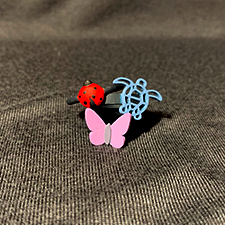
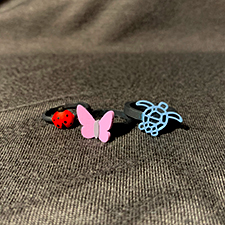
Create a free standing 3D expression derived from a 1 to 30 seconds of recorded sound. Consider using space and multiples as a factor instead of a singular composition.
For my sound project, I recorded my dog’s bark. His bark is very deep. In the recording, it has a sharpness to it. It came in almost three bursts, so I created three different pieces of what I heard. The first burst had a bit of a rumble to it, almost a growl. I used rounded smooth edges to depict this. The second burst way very flamboyant. It seemed to go in many directions. I pictured something almost like ribbon flying around. The third burst was the sharpest and came the fastest and most frequent. I created sharp, pointed edges that were close together.
